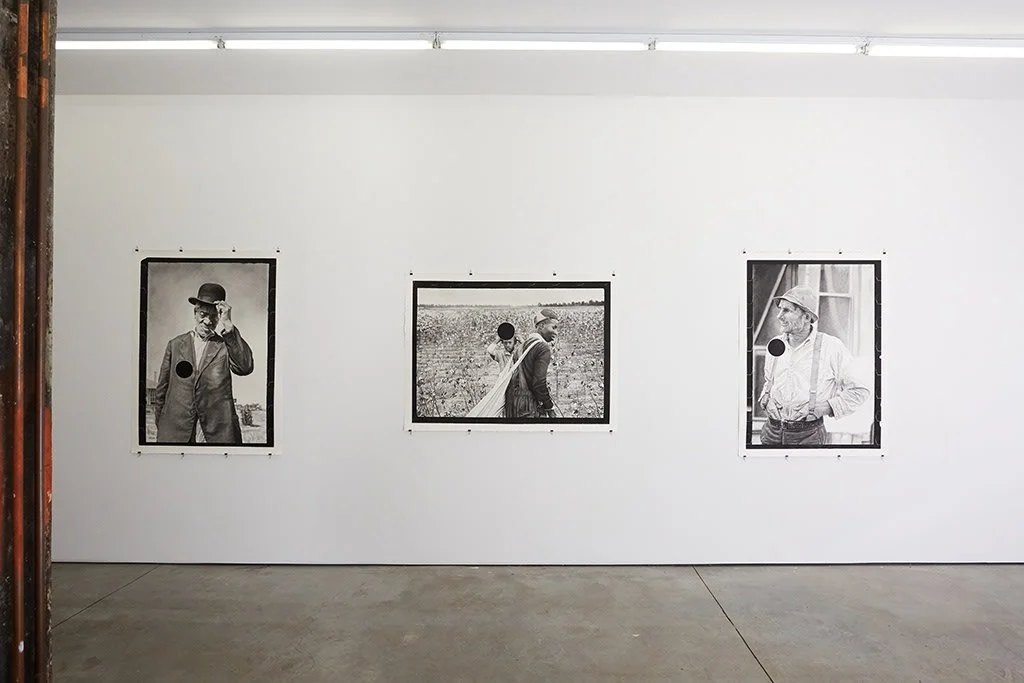CANDACE G. WILEY and JOEL DANIEL PHILLIPS: The Girl Speaks
Oil Painting and Accompanying Poem
[Archive Text: “Untitled.” Original 35mm nitrate negative by Unknown Photographer
dated between 1935 and 1942. Courtesy of the Library of Congress.]
The Girl Speaks • 40in x 60in • Oil on Canvas • 2022
I ain’t never seen a good photograph of a negro. Not in all my years.
And one thing I know for sure is, I ain’t fitna end up like those negroes,
‘specially not before I even get to seventh grade and find out if Bobby Hall
like-likes me. No sir, not me. You not gonna get me in that box and turn me
into a frayed-rope constellation, spread star by star across the county.
Or into a sermon, Sunday after wailing Sunday. No, mister white man,
who I do not know and ain’t never seen, I ain’t ‘bout to let you
turn my family into pillars of ocean water sloshing at the joints,
legs so heavy they shush the ground with they feet. I seen it!
Old folks sliding bits of newspaper into big Family Bibles,
ink from a new date looped and puddled. A leaflet smuggled
under hankies in Grandma Tressie’s top drawer. Postcards for sale.
The man’s head slung like he just left an interview deflated,
or like he’d had a passing thought he had to tilt to consider.
I’m not going to be in your photograph. In fact, that’s okay.
I’ll do you one better. I see your black eye trying to swallow me,
opening like a fish. I see myself in your window. Already lost
my right arm inside you. I reckon maybe I’ll just crawl right in
and get it back and then bust you wide open. I bet when I crawl
in there I’ll find all the other negroes you stole, frozen in time,
scattered like statues around your granite garden. The real thems,
not the fake ones the newspapers say did this and that to some
aint-got-enough-business-to-mind white folk. I’ll find the ones
that cain’t be in some bedroom across the tracks and also at a barbeque
down my way. The ones who’ll bloom up an eye just like yours
if you step to they family wrong. The mouthy ones like me
who got something to say and good reason to say it. No, mr. camera,
don’t back off now. I ain’t ask to take no photograph and you ain’t ask me,
but today you can call me Moses and you be Pharoah
I got a black sea to split and you gon’ let my people go.
ABOUT THE PROJECT
”Killing the Negative”
“Killing the Negative” is an ongoing, multi-year collaboration between poet Quraysh Ali Lansana and draftsman Joel Daniel Phillips consisting of a series of poems and drawings in response to censored government photographs of the Great Depression. Phillips’ meticulous charcoal and graphite drawings are paired with poetic interventions by Lansana and other poets, both filling the purposefully vacant spaces left by government censorship and creating an entirely new conversation about power, representation, and the shaping of America’s historical narratives.
In addition to contributions by lead poet and editor Lansana, the body of work features poetic interventions from some of the leading voices in American Poetry today, including U.S. Poet Laureate Joy Harjo, North Carolina Poet Laureate Jaki Shelton Green and Dr. Randall Horton.
Commissioned by the Roosevelt Administration as a part of the New Deal, the original Farm Security Administration (FSA) images are of course, well known. Images like “Migrant Mother” by Dorothea Lange have become some of the most recognizable and important images in the American photographic lexicon. Less known, however, is the process by which these images were selected for publication: Roy Stryker was the head of the FSA, and for the first 4 years of the project, images he deemed unworthy were “killed” by punching a hole in the original negative.
The larger contemporary political landscape is one that makes many of the questions from the era of the Great Depression deeply resonant; questions of race, class, labor and compensation, land ownership, stratified socio-economics and ecological protection are embedded in the original censored FSA photographs. The collaboration between Lansana and Phillips responds to the echoing voids in the narrative created by the censorship, weaving new images and words into the spaces left by Stryker’s hole punch. Within the project, Stryker’s destructive editing process acts as a larger commentary on truth and the veracity of the historical record, pointing out the flaws in our reliance on this record, and calling into startling clarity the power that a single individual had to shape the collective understanding of an entire nation.


